How does the bitcoin source code define its 21 million cap?
Many of bitcoin’s staunchest critics have expressed doubt about its 21 million cap, but perhaps the most mindless criticism relates…
,
Contrary to popular belief, bitcoin is in fact backed by something. It is backed by the only thing that backs any form of money: the credibility of its monetary properties. Money is not a collective hallucination nor merely a belief system. Over the course of history, various mediums have emerged as money, and each time, it has not just been by coincidence. Goods that emerge as money possess unique properties that differentiate them from other market goods. While The Bitcoin Standard provides a more full discussion, monetary goods possess unique properties that make them particularly useful as a means of exchange; these properties include scarcity, durability, divisibility, fungibility and portability, among others. With each emergent money, inherent properties of one medium improve upon and obsolete the monetary properties inherent in a pre-existing form of money, and every time a good has monetized, another has demonetized. Essentially, the relative strengths of one monetary medium out-compete that of another, and bitcoin is no different. It represents a technological advancement in the global competition for money; it is the superior successor to gold and the fiat money systems that leveraged gold’s monetary properties.
Bitcoin is out-competing its analog predecessors on the basis of its monetary properties. Bitcoin is finitely scarce, and it is more easily divisible and more easily transferable than its incumbent competitors. It is also more decentralized, and as a derivative, more resistant to censorship or corruption. There will only ever be 21 million bitcoin, and each bitcoin is divisible to eight decimal points (1 one-hundred millionth). Value can be transferred to anyone and anywhere in the world on a permissionless basis, and final settlement does not rely on any third-party. In aggregate, its monetary properties are vastly superior to any other form of money used today. And, these properties do not exist by chance, nor do they exist in a vacuum. The emergent monetary properties in bitcoin are secured and reinforced through a combination of cryptography, a network of decentralized nodes enforcing a common set of consensus rules, and a robust mining network ensuring the integrity and immutability of bitcoin’s transaction ledger. The currency itself is the keystone which binds the system together, creating economic incentives that allow the security columns to function as a whole. But even still, bitcoin’s monetary properties are not absolute; instead, these properties are evaluated by the market relative to the properties inherent in other monetary systems.

Recognize that every time a dollar is sold for bitcoin, the exact same number of dollars and bitcoin exist in the world. All that changes is the relative preference of holding one currency versus another. As the value of bitcoin rises, it is an indication that market participants increasingly prefer holding bitcoin over dollars. A higher price of bitcoin (in dollar terms) means more dollars must be sold to acquire an equivalent amount of bitcoin. In aggregate, it is an evaluation by the market of the relative strength of monetary properties. Price is the output. Monetary properties are the input. As individuals evaluate the monetary properties of bitcoin, the natural question becomes: which possesses more credible monetary properties? Bitcoin or the dollar? Well, what backs the dollar (or euro or yen, etc.) in the first place? When attempting to answer this question, the retort is most often that the dollar is backed by the government, the military (guys with guns), or taxes. However, the dollar is backed by none of these. Not the government, not the military and not taxes. Governments tax what is valuable; a good is not valuable because it is taxed. Similarly, militaries secure what is valuable, not the other way around. And a government cannot dictate the value of its currency; it can only dictate the supply of its currency.
Venezuela, Argentina, and Turkey all have governments, militaries and the authority to tax, yet the currencies of each have deteriorated significantly over the past five years. While it’s not sufficient to prove the counterfactual, each is an example that contradicts the idea that a currency derives its value as a function of government. Each and every episode of hyperinflation should be evidence enough of the inherent flaws in fiat monetary systems, but unfortunately it is not. Rather than understanding hyperinflation as the logical end game of all fiat systems, most simply believe hyperinflation to be evidence of monetary mismanagement. This simplistic view ignores first principles, as well as the dynamics which ensure monetary debasement in fiat systems. While the dollar is structurally more resilient as the global reserve currency, the underpinning of all fiat money is functionally the same, and the dollar is merely the strongest of a weak lot. Once the mechanism(s) that back the dollar (and all fiat systems) is better understood, it provides a baseline to then evaluate the mechanisms that back bitcoin.
The value of the dollar did not emerge on the free market. Instead, it emerged as a fractional representation of gold (and silver initially). Essentially, the dollar was a solution to the inherent limitations in the convertibility and transferability of gold; its inception was dependent on the monetary properties of base metals, rather than properties inherent in the dollar itself. It was also initially a system based on trust: accept dollars and trust that it could be converted back to gold at a fixed amount in the future. Gold’s limitation and ultimate failure as money is the dollar system, and without gold, the dollar would have never existed in its current construct. For a quick review of the dollar’s history with gold:
| 1900 | Gold Standard Act of 1900 established that gold was the only metal convertible to the dollar; gold convertible to dollars at $20.67/oz. |
| 1913 | The Federal Reserve was created as part of the Federal Reserve Act of 1913. |
| 1933 | President Roosevelt banned the hoarding (saving) of gold via Executive Order 6102, requiring citizens to convert gold to dollars at $20.67 per ounce or face a penalty in the form of a fine up to $10,000 and/or up to 5 to 10 years imprisonment. |
| 1934 | President Roosevelt signed the Gold Reserve Act, devaluing the dollar by approximately 40% to $35 per ounce of gold. |
| 1944 | Bretton Woods agreement formalized ability of foreign governments and central banks to convert gold to dollars (and vice versa) at $35/oz and established fixed exchange ratios between dollars and other foreign currencies. |
| 1971 | President Nixon officially ended all convertibility of dollars to gold, effectively ending the Bretton Woods system. The value of dollar was changed to $38/oz of gold. |
| 1973 | The U.S. government repriced gold to $42 per ounce. |
| 1976 | The U.S. government then decoupled the value of the dollar from gold altogether in 1976. |
Over the course of the twentieth century, the dollar transitioned from a reserve-backed currency to a debt-backed currency. While most people never stop to consider why the dollar has value in the post gold era, the most common explanation remains that it is either a collective hallucination (i.e. the dollar has value simply because we all believe it does), or that it is a function of the government, the military, and taxes. Neither explanation has any basis in first principles, nor is it the fundamental reason why the dollar retains value. Instead, today, the dollar maintains its value as a function of debt and the relative scarcity of dollars to dollar-denominated debt. In the dollar world, everything is a function of the credit system. Nominal GDP is functionally dependent on the size, and growth of the credit system, and taxes are a derivative of nominal GDP. The mechanisms that fund the government (taxes and deficit spending) are both dependent on the credit system, and it is the credit system that allows the dollar to function in its current construct.
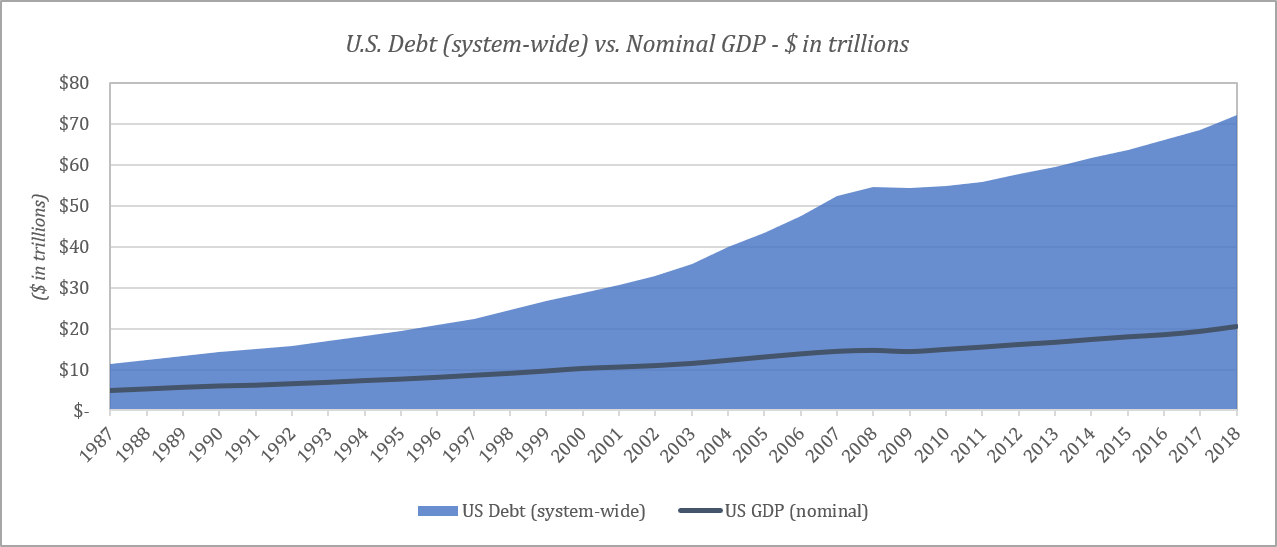
The size of the credit system is several times larger than nominal GDP. Because the credit system is also orders of magnitude larger than the base money supply, economic activity is largely coordinated by the allocation and expansion of credit. However, the growth of the credit system has far outpaced the growth of GDP over the course of the last three decades. The chart below indexes the rate of change of the credit system compared to the rate of change of both nominal GDP and federal tax receipts (from 1987 to today). In the Fed’s system, credit expansion drives nominal GDP which ultimately dictates the nominal level of federal tax receipts.
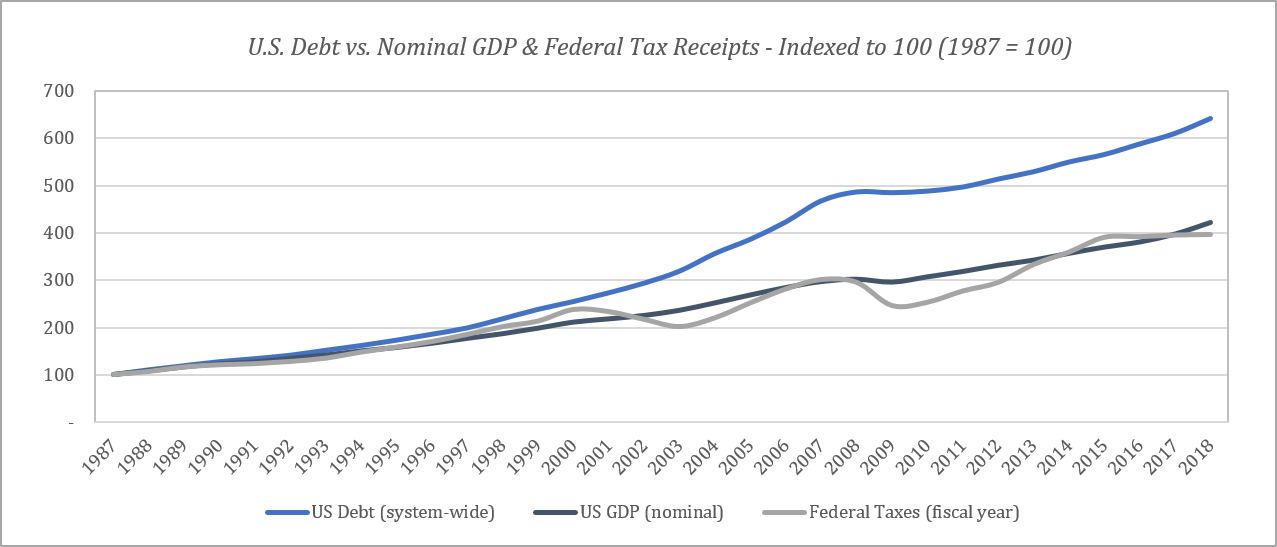
Today, there is $73 trillion of debt (fixed maturity / fixed liability) in the U.S. credit system according to the Federal Reserve (z.1 report), but there are only $1.6 trillion actual dollars in the banking system. This is how the Fed manages the relative stability of the dollar. Debt creates future demand for dollars. In the Fed’s system, each dollar is leveraged approximately 40:1. If you borrow dollars today, you need to acquire dollars in the future to repay that debt, and currently, each dollar in the banking system is owed 40 times over. The relationship between the size of the credit system relative to the amount of dollars gives the dollar relative scarcity and stability. In aggregate, everyone needs dollars to repay dollar denominated credit.
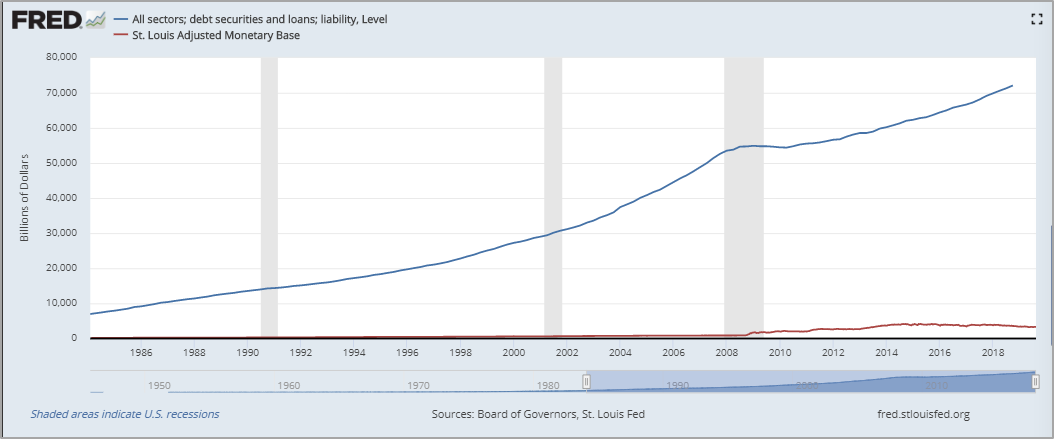
The system as a whole owes far more dollars than exist, creating an environment where on net there is a very high present demand for dollars. If consumers did not pay debt, their homes would be foreclosed upon, or their cars would be repossessed. If a corporation did not pay debt, company assets would be forfeited to creditors via a bankruptcy process, and equity could be entirely wiped out. If a government did not pay debt, basic government functions would be shut down due to lack of funding. In most cases, the consequence of not securing the future dollars necessary to repay debt means losing the shirt on your back. Debt creates the ultimate incentive to demand dollars. So long as dollars are scarce relative to the amount of outstanding debt, the dollar remains relatively stable. This is how the Fed’s economy works, incentivize credit creation and you create the source of future demand for the underlying currency. In a sense, it’s kind of like a drug dealer. Get an addict hooked on your drug and he will keep coming back for more. In this case, the drug is debt, and it forces everyone, on net, to stay on the dollar hamster wheel.
The problem for the Fed’s economy (and the dollar) is that it depends on the functioning of a highly leveraged credit system. And in order to sustain it, the Fed must increase the amount of base dollars. This is what quantitative easing is and why it exists. In order to sustain the amount of debt in the system, the Fed has to systematically increase the supply of actual dollars, otherwise the credit system would collapse. Increasing the amount of base dollars has the immediate effect of deleveraging the credit system, but it has the longer-term effect of inducing more credit. It also has the effect of devaluing the dollar gradually over time. This is all by design. Credit is ultimately what backs the dollar because what the credit actually represents is claims on real assets, and consequently, people’s livelihoods. Come with dollars in the future or risk losing your house is an incredible incentive to work for dollars.
The relationship between dollars and dollar credit keeps the Fed’s game in play, and central bankers believe this can go on forever. Create more dollars; create more debt. Too much debt? Create more dollars, and so on. Ultimately, in the Fed’s (or any central bank’s) system, the currency is the release valve. Because there is $73 trillion of debt and only $1.6 trillion dollars in the U.S. banking system, more dollars will have to be added to the system to support the debt. The scarcity of dollars relative to the demand for dollars is what gives the dollar its value. Nothing more, nothing less. Nothing else backs the dollar. And while the dynamics of the credit system create relative scarcity of the dollar, it is also what ensures dollars will become less and less scarce on an absolute basis.
Too much debt → Create more money → More debt → Too much debt
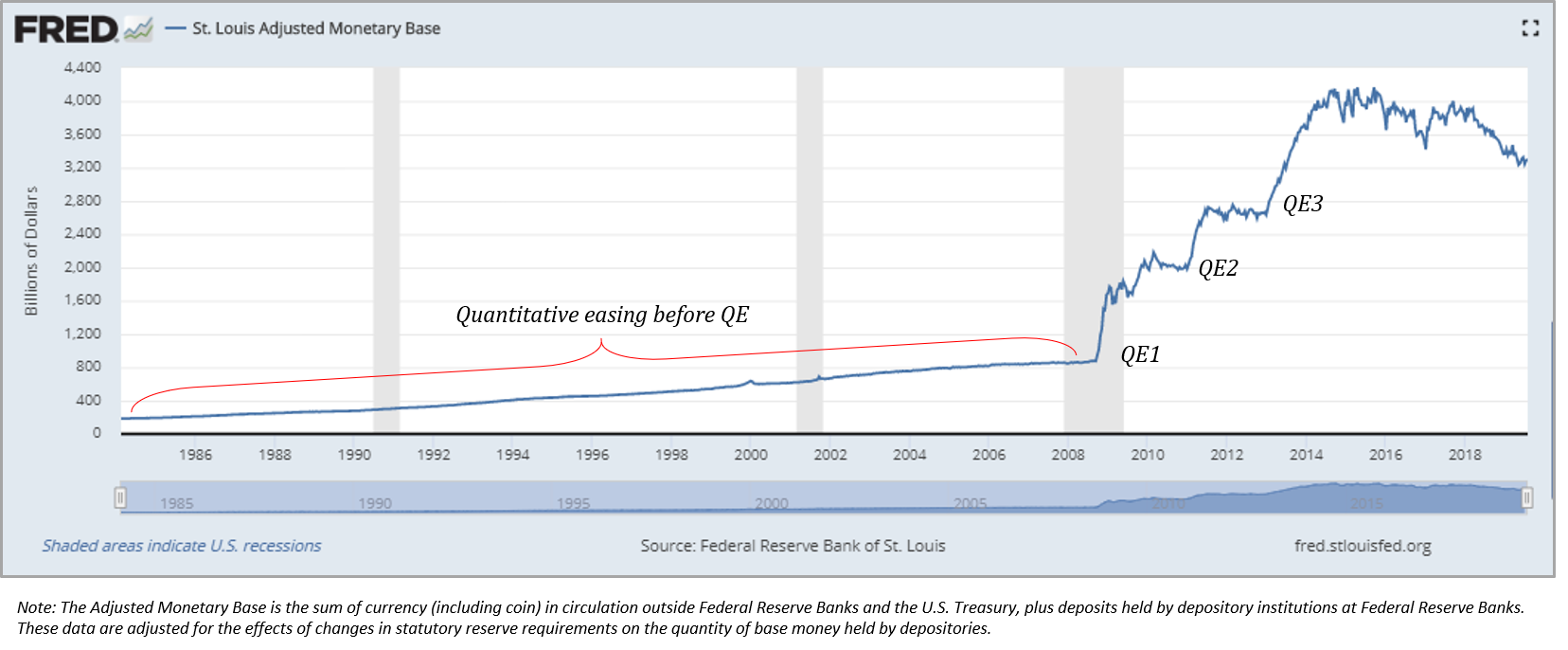
As is the case with any monetary asset, scarcity is the monetary property that backs the dollar, but the dollar is only scarce relative to the amount of dollar-denominated debt that exists. And it now has real competition in the form of bitcoin. The dollar system and its lack of inherent monetary properties provides a stark contrast to the monetary properties emergent and inherent in bitcoin. Dollar scarcity is relative; bitcoin scarcity is absolute. The dollar system is based on trust; bitcoin is not. The dollar’s supply is governed by a central bank, whereas bitcoin’s supply is governed by a consensus of market participants. The supply of dollars will always be wed to the size of its credit system, whereas the supply of bitcoin is entirely divorced from the function of credit. And, the cost to create dollars is marginally zero, whereas the cost to create bitcoin is tangible and ever increasing. Ultimately, bitcoin’s monetary properties are emergent and increasingly unmanipulable, whereas the dollar is inherently and increasingly manipulable.
The hardest mental hurdle to overcome, when evaluating bitcoin as money, is often that it is digital. Bitcoin is not tangible, and on the surface, it is not intuitive. How could something entirely digital be money? While the dollar is mostly digital, it remains far more tangible than bitcoin in the mind of most. While the digital dollar emerged from its paper predecessor and physical dollars remain in circulation, bitcoin is natively digital. With the dollar, there is a physical representation that anchors our mental models in the tangible world; with bitcoin, there is not. While bitcoin possesses far more credible monetary properties than the dollar, the dollar has always been money (for most of us), and as a consequence, its digital representation is seemingly a more intuitive extension from the physical to the digital world. While the dollar’s basis as money is anchored in time and while its digital nature may seem more tangible, bitcoin represents finite scarcity. The supply of the dollar on the other hand has no limits.
Remember that the dollar does not have any inherent monetary properties. It leveraged the monetary properties of gold in its ascent to global reserve status, but in itself, there are no unique properties that ground the dollar as a stable form of money, other than its relative scarcity in the construct of its credit-linked monetary system. When evaluating bitcoin, the first principle question to consider is whether something digital could share the quintessential properties that made gold a store of value (and a form of money). Did gold emerge as money because it was physical or because it possessed transcendent properties beyond being physical? Of all the physical objects in the world, why gold? Gold emerged as money not because it was physical, but instead because its aggregate properties were unique. Most importantly, gold is scarce, fungible and highly durable. While gold possessed many properties which made it superior to any money that came before it, its fatal flaw was that it was difficult to transport and susceptible to centralization, which is ultimately why the dollar emerged as its transactional counterpart.
“As a thought experiment, imagine there was a base metal as scarce as gold but with the following properties: – boring grey in colour – not a good conductor of electricity – not particularly strong, but not ductile or easily malleable either – not useful for any practical or ornamental purpose and one special, magical property: – can be transported over a communications channel”
– Satoshi Nakamoto (August 27, 2010)
Bitcoin shares the monetary properties that caused gold to emerge as a monetary medium, but it also improves upon gold’s flaws. While gold is relatively scarce, bitcoin is finitely scarce and both are extremely durable. While gold is fungible, it is difficult to assay; bitcoin is fungible and easy to assay. Gold is difficult to transfer and highly centralized. Bitcoin is easy to transfer and highly decentralized. Essentially, bitcoin possesses all of the desirable traits of both physical gold and the digital dollar combined in one, but without the critical flaws of either. When evaluating monetary mediums, first principles are fundamental. Ignore the conclusion or end point, and start by asking yourself: if bitcoin were actually scarce and finite, ignoring that it is digital, could that be an effective measure of value and ultimately a store of value? Is scarcity a sufficiently powerful property that bitcoin could emerge as money, regardless of whether the form of that scarcity is digital?
While money may be an intangible concept, so long as there are benefits from trade and specialization, there is real demand and utility in money. Money is the tool we use to be the arbiter in determining relative value among more abundant consumption goods and capital goods. It is the good that coordinates all other economic activity. The absolute quantity of money is less important than its properties of being scarce and measurable. Scarcity is money’s most important property. If supply of the unit of measure were constantly and unpredictably changing, it would be very difficult to measure the value of goods relative to it, which is why scarcity, on its own, is an incredibly valuable property. While the value of the underlying measurement unit may fluctuate relative to goods and services, stability in the supply of money results in the least amount of noise in the relative price signal of other goods.
Despite being digital, bitcoin is designed to provide absolute scarcity, which is why it has the potential to be such an effective form of money (and measure of value). There will only ever be 21 million bitcoin, and 21 million is a scarily small number in relative and absolute terms. The Fed created $100 billion dollars just last week, with the click of a button. That is approximately $5,000 per bitcoin that will ever exist, created in just a week (and by only one central bank). To provide broader context, the Federal Reserve, the Bank of Japan and the European Central bank have collectively created $10 trillion dollars-worth of new money since the financial crisis, the equivalent of approximately $500,000 per bitcoin. Despite dollars, euro, yen and bitcoin all being digital, bitcoin is the only medium that is tangibly scarce and the only one with inherent monetary properties.
However, it is insufficient to simply claim that bitcoin is finitely scarce; nor should anyone simply accept this as fact. It is important to understand how and why that is the case. Why can’t more than 21 million bitcoin be created and why can’t it be copied? Why is bitcoin secure and why can’t it be manipulated? While there are countless building blocks that collectively allow bitcoin to function with a reliably fixed supply, there are three key columns of security within the bitcoin network which are woven together and reinforced by the economic incentives of the currency itself:
21 million is not just a number guaranteed by software. Instead, bitcoin’s fixed 21 million supply is governed by a consensus mechanism, and all market participants have an economic incentive to enforce the rules of the bitcoin network. While a consensus of the bitcoin network could theoretically determine to increase the supply of bitcoin such that it exceeds 21 million, an overwhelming majority of bitcoin users would have to collectively agree to debase their own currency in order to do so. In practice, a global and decentralized network of rational economic actors, operating within a voluntary, opt-in currency system would not collectively and overwhelmingly form a consensus to debase the currency which they have all independently and voluntarily determined to use as a store of wealth. This reality then underpins and reinforces bitcoin’s economic incentives, technical architecture and network effect.
In bitcoin, a full node is a computer or server that maintains a full version of the bitcoin blockchain. Full nodes independently aggregate a version of the blockchain based on a common set of network consensus rules. While not everyone that holds bitcoin runs a full node, everyone is able to do so, and each node validates all transactions and all blocks. By running a full node, anyone can access the bitcoin network and broadcast transactions (or blocks) on a permissionless basis. And nodes do not trust any other nodes. Instead, each node independently verifies the complete history of bitcoin transactions based on a common set of rules, allowing the network to converge on a consistent and accurate version of history on a trustless basis.
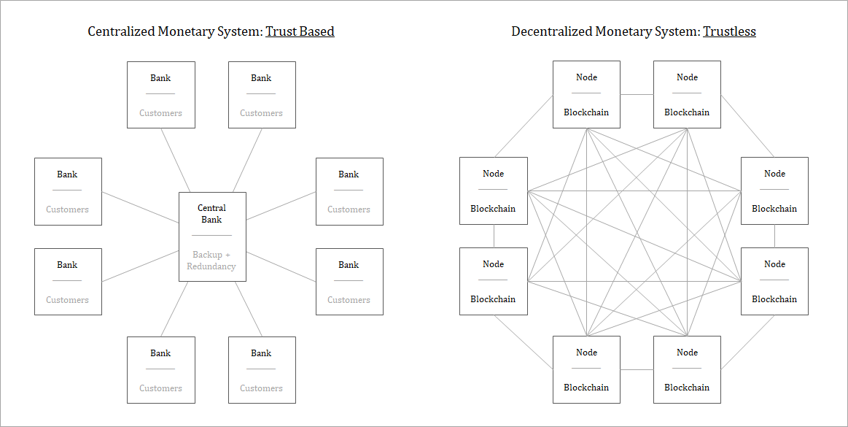
This is the mechanism by which the bitcoin network removes trust in any centralized third-party and hardens the credibility of its fixed supply. All nodes maintain a history of all transactions, allowing each node to determine whether any future transaction is valid. In aggregate, bitcoin represents the most secure computing network in the world because anyone can access it and no one trusts anyone. The network is decentralized and there are no single points of failure. Every node represents a check and balance on the rest of the network, and without a central source of truth, the network is resistant to attack and corruption. Any node could fail or could become corrupted, and the rest of the network would remain unimpacted. The more nodes that exists, the more decentralized bitcoin becomes, which increases redundancy, making the network harder and harder to corrupt or censor.
Each full node enforces the consensus rules of the network, a critical element of which is the currency’s fixed supply. Each bitcoin block includes a pre-defined number of bitcoin to be issued and each bitcoin transaction must have originated from a previously valid block in order to be valid. Every 210,000 blocks, the bitcoin issued in each valid block is cut in half until the amount of bitcoin issued ultimately reaches zero in approximately 2140, creating an asymptotic, capped supply schedule. Because each node independently validates every transaction and each block, the network collectively enforces the fixed 21 million supply. If any node broadcasts an invalid transaction or block, the rest of the network would reject it and that node would fall out of consensus. Essentially, any node could attempt to create excess bitcoin, but every other node has an interest in ensuring the supply of bitcoin is consistent with the pre-defined fixed limit, otherwise the currency would be arbitrarily debased at the direct expense of the rest of the network.
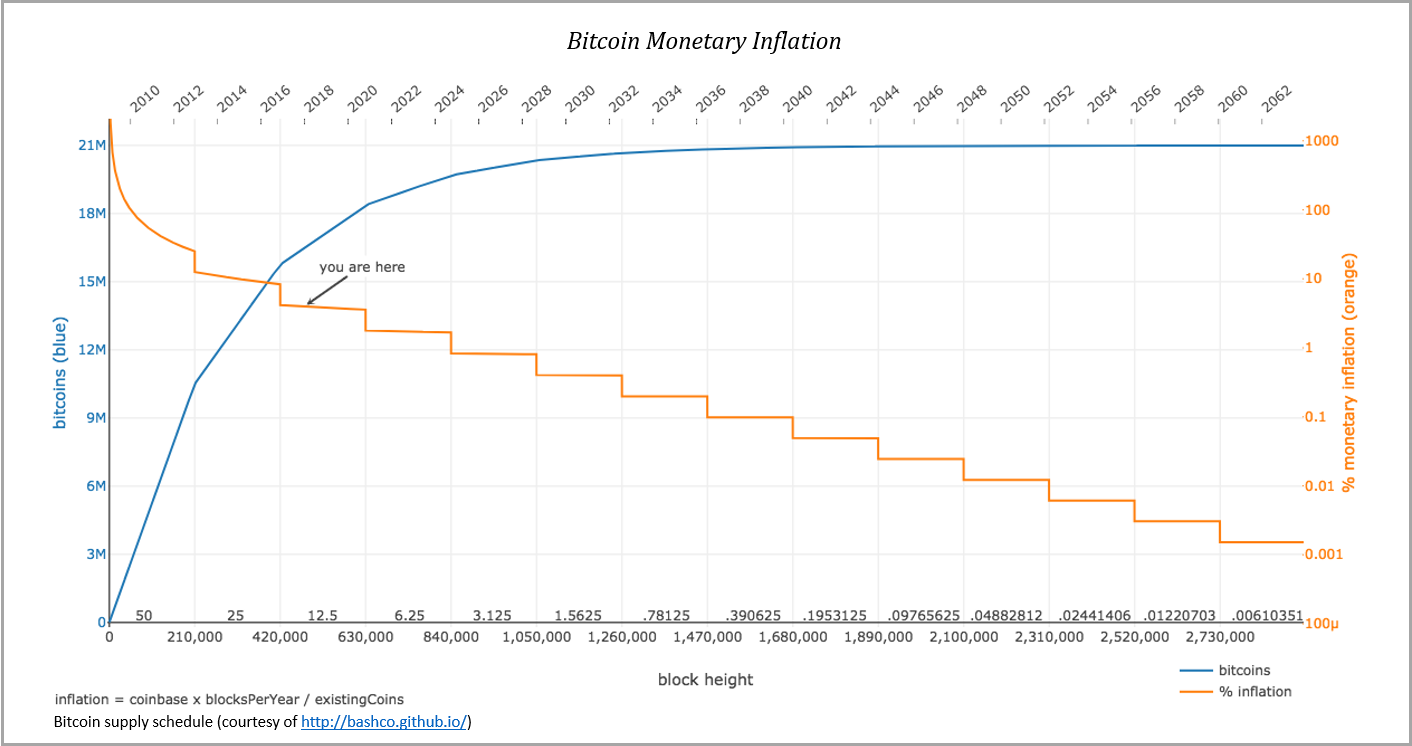
Separately, anyone within or outside the network could copy bitcoin’s software to create a new version of bitcoin, but any units created by such a copy would be considered invalid by the nodes operating within the bitcoin network. Any subsequent copies or units would not be considered valid, nor would anyone accept the currency as bitcoin. Each bitcoin node independently validates whether a bitcoin is a bitcoin, and any copy of bitcoin would be invalid, as it would not have originated from a previously valid bitcoin block. It would be like trying to pass off monopoly money as dollars. You can wish it to be money all you want, but no one would accept it as bitcoin, nor would it share the emergent properties of the bitcoin network. Running a bitcoin full node allows anyone to instantly assay whether a bitcoin is valid, and any copy of bitcoin would be immediately identified as counterfeit. The consensus of nodes determines the valid state of the network within a closed-loop system; anything that occurs beyond its walls is as if it never happened.
As part of the consensus mechanism, certain nodes (referred to as miners) perform bitcoin’s proof of work function to add new bitcoin blocks to the blockchain. This function validates the complete history of transactions and clears pending transactions. The process of mining is ultimately what anchors bitcoin security in the physical world. In order to solve blocks, miners must perform trillions of cryptographic computations, which require expending significant energy resources. Once a block is solved, it is proposed to the rest of the network for validation. All nodes (including other miners) verify whether a block is valid based on a common set of network consensus rules discussed previously. If any transaction in the block is invalid, the entire block is invalid. Separately, if a proposed block does not build on the latest valid block (i.e. the longest version of the block chain), the block is also invalid.
For context, at 90 exahashes per second, the bitcoin network currently consumes approximately 9 gigawatts of power, which translates to ~$11 million per day (or ~$4 billion per year) of energy at a marginal cost of 5 cents per kWh (rough estimates). Blocks are solved on average every ten minutes, which translates to approximately 144 blocks per day. Across the network, each block costs approximately $75,000 to solve, and the reward per block is approximately $100,000 (12.5 new bitcoin x $8,000 per bitcoin, excluding transaction fees). The higher the cost to solve a block, the more costly the network is to attack. The cost to solve a block represents the tangible resources it requires to write history to the bitcoin transaction ledger. As the network grows, the network becomes more fragmented, and the economic value compensated to miners in aggregate increases. From a game theory perspective, more competition and greater opportunity cost makes it harder to collude, and all network nodes validate the work performed by miners, which serves as a constant check and balance.
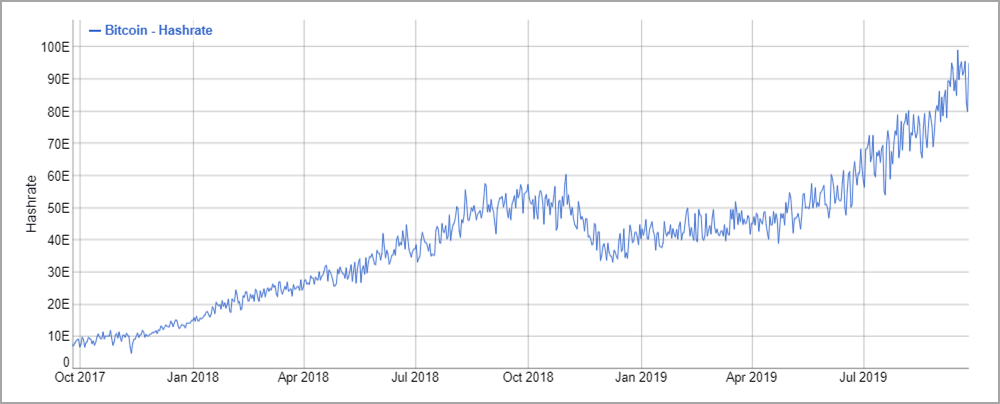
And recall that a pre-defined number of bitcoin are issued in each valid block (that is, until the 21 million limit is reached). The bitcoin issued in each block combined with network transaction fees represent the compensation to miners for performing the proof-of-work function. The miners are paid in bitcoin to secure the network. As part of the block construction and proposal process, miners include the pre-defined number of bitcoin to be issued as compensation for expending tangible, real world resources to secure the network. If a miner were to include an amount of bitcoin inconsistent with the pre-defined supply schedule as compensation, the rest of the network would reject the block as invalid. As part of the security function, miners must validate and enforce the fixed supply of the currency in order to be compensated. Miners have material skin-in-the-game in the form of upfront capital costs (and energy expenditure), and invalid work is not rewarded.
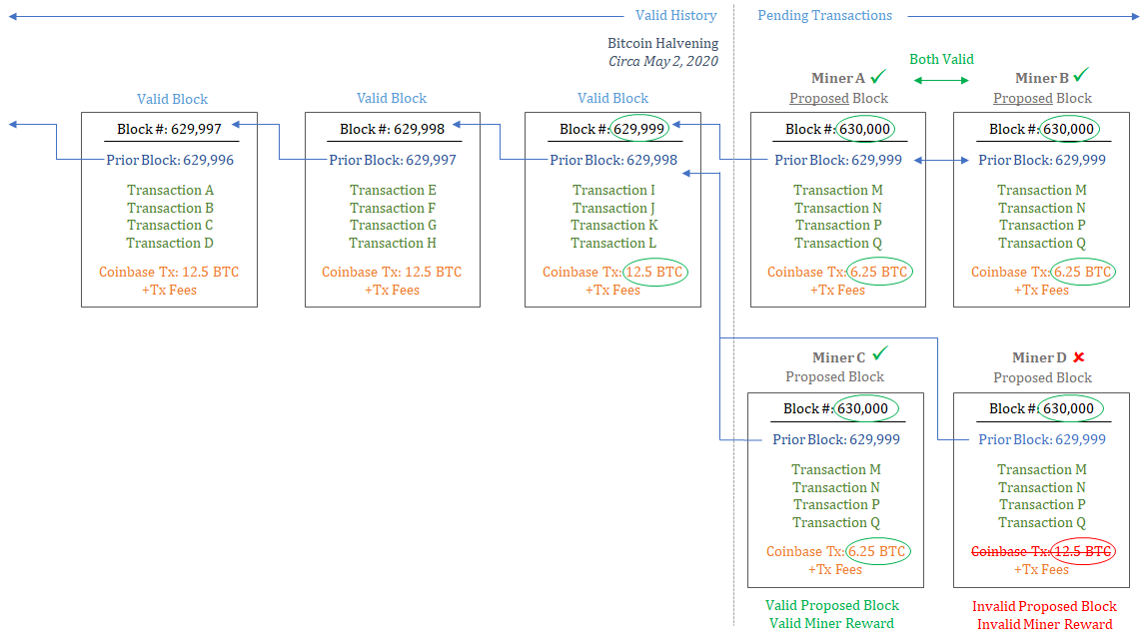
For a technical example, the valid reward paid to miners is halved every 210,000 blocks with the next halvening (a “technical” term) scheduled to occur at block 630,000 (or approximately in May 2020). At the time and scheduled block of the next halvening, the valid reward will be reduced from 12.5 bitcoin to 6.25 bitcoin per block. Thereafter, if any miner includes an invalid reward (an amount other than 6.25 bitcoin), the rest of the network will reject it as invalid. The halvening is important not just because the supply of newly issued bitcoin is reduced, but also because it demonstrates that the economic incentives of the network continue to effectively coordinate and enforce the fixed supply of the currency on an entirely decentralized basis. If any miner attempts to cheat, it will be maximally penalized by the rest of the network. Nothing other than the economic incentives of the network coordinate this behavior; that it occurs on a decentralized basis without the coordination of any central authority reinforces the security of the network.
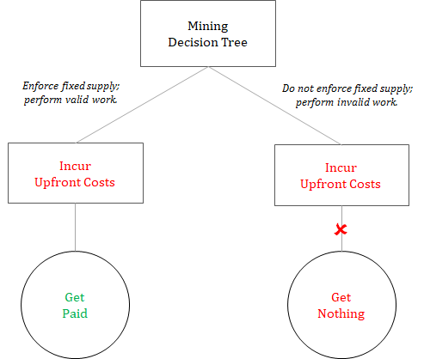
Because mining is decentralized and because all miners are constantly competing with all other miners, it is not practical for miners to collude. Separately, all nodes validate the work performed by miners, instantly and at practically no cost, which creates a very powerful check and balance that is divorced from the mining function itself. Blocks are costly to solve but easy to validate; in aggregate, this is a fundamental differentiator between bitcoin and the monetary systems with which bitcoin competes, whether gold or the dollar. And the compensation paid to miners for securing the network and enforcing the network’s fixed supply is exclusively in the form of bitcoin. The economic incentives of the currency (compensation) is so strong and the penalty is both so severe and so easily enforced that miners are maximally incentivized to cooperate and perform valid work. By introducing tangible cost to the mining process, by incorporating the supply schedule in the validation process (which all nodes verify), and by divorcing the mining function from ownership of the network, the network as a whole reliably and perpetually enforces the fixed supply (21 million) of the currency on a trustless basis, while also able to reach consensus on a decentralized basis.
While miners construct, solve and propose blocks and while nodes check and validate work performed by miners, private keys control access to the unit of value itself. Private keys control the rights to the 21 million bitcoin (technically only 18.0 million have been mined to date). In bitcoin, there are no identities; bitcoin knows nothing of the outside world. The bitcoin network validates signatures and keys. That is all. Only someone in control of a private key can create a valid bitcoin transaction by creating a valid signature. Valid transactions are included in blocks, which are solved by miners and validated by each node, but only those in possession of private keys can produce valid transactions.
When a valid transaction is broadcast, bitcoin are spent (or transferred) to specific bitcoin public addresses. Public addresses are derived from public keys, which are derived from private keys. Public keys and public addresses can be calculated using a private key, but a private key cannot be calculated from a public key or public address. It is a one-way function secured by strong cryptography. Public keys and public addresses can be shared without revealing anything about the private keys. When a bitcoin is spent to a public address, it is essentially locked in a safe, and in order to unlock the safe to spend the bitcoin, a valid signature must be produced by the corresponding private key (every public key and address has a unique private key). The owner of the private key produces a unique signature, without actually revealing the secret itself. The rest of the network can verify that the holder of the private key produced a valid signature, without actually knowing any details of the private key itself. Public and private key pairs are the foundation of bitcoin. And ultimately, private keys are what control access rights to the economic value of the network.
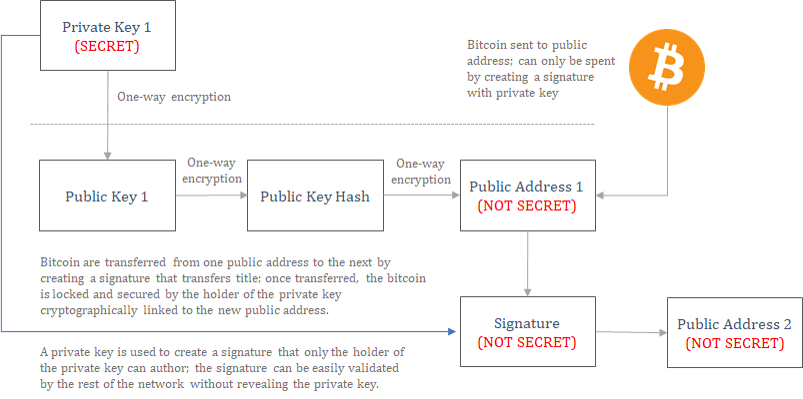
It doesn’t matter whether someone has one-tenth of a bitcoin or ten thousand bitcoin. Either and each are secured and validated by the same mechanism and by the same rules. Everyone has equal rights. Regardless of the economic value, each bitcoin (and bitcoin address) is treated identically within the bitcoin network. If a valid signature is produced, the transaction is valid and it will be added to the blockchain (if a transaction fee is paid). If an invalid signature is produced, the network will reject it as invalid. It does not matter how powerful or how weak any particular participant may be. Bitcoin is apolitical. All it validates is keys and signatures. Someone with more bitcoin may be able to pay a higher fee to have a transaction prioritized, but all transactions are validated based on the same set of consensus rules. Miners prioritize transactions based on value and profitability, nothing else. If a transaction is equally valuable, it will be prioritized based on a time sequence. But importantly, the mining function, which clears transactions, is divorced from ownership. Bitcoin is not a democracy; ownership is controlled by keys and every bitcoin transaction is evaluated based on the same criteria within the network. It is either valid or it is not. And every bitcoin must have originated within a block consistent with the 21 million supply schedule in order to be valid.
This is why users controlling keys is such a significant ethos in bitcoin. Bitcoin are extremely scarce, and private keys are the gatekeeper to the transfer of every bitcoin. The saying goes: not your keys, not your bitcoin. If a third-party party controls your keys, such as a bank, that entity is in control of your access to the bitcoin network, and it would be very easy to restrict access or seize funds in such a scenario. While many people choose to trust a bank-like entity, the security model of bitcoin is unique; not only can each user control their own private keys, but each user can also access the network on a permissionless basis and transfer funds to anyone anywhere in the world. This is only possible if a user is in control of a private key. In aggregate, users controlling private keys decentralize the control of the network’s economic value, which increases the security of the network as a whole. The more distributed access is to the network, the more challenging it becomes to corrupt or co-opt the network. Separately, by holding a private key, it becomes extremely difficult for anyone to restrict access or seize funds held by any individual. Every bitcoin in circulation is secured by a private key; miners and nodes may enforce that 21 million bitcoin will ever exist, but the valid bitcoin that do exist are ultimately controlled and secured by a private key.
In summary, the supply of bitcoin is governed by a network consensus mechanism, and miners perform a proof-of-work function that grounds bitcoin’s security in the physical world. As part of the security function, miners get paid in bitcoin to solve blocks, which validate history and clear pending bitcoin transactions. If a miner attempts to compensate themselves in an amount inconsistent with bitcoin’s fixed supply, the rest of the network will reject the miner’s work as invalid. The supply of the currency is integrated into bitcoin’s security model, and real world energy resources must be expended in order for miners to be compensated. Still yet, every node within the network validates the work performed by all miners, such that no one can cheat without a material risk of penalty. Bitcoin’s consensus mechanism and validation process ultimately governs the transfer of ownership of the network, but ownership of the network is controlled and protected by individual private keys held by users of the network.
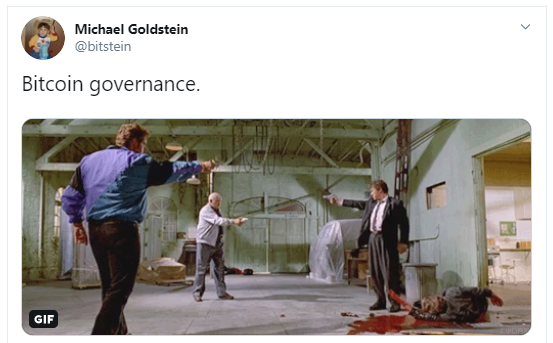

Set aside any preconceived notions of what money is, and imagine a currency system that has an enforceably scarce and fixed supply. Anyone in the world can connect to the network on a permissionless basis and anyone can send transactions to anyone anywhere in the world; everyone can also independently and easily validate the supply of the currency as well as ownership across the network. Imagine a global economy where billions of people, disparately located throughout the world, can transact across one common decentralized network, and everyone can arrive at the same consensus of the ownership of the network, without the coordination of any central party. How valuable would that network be? Bitcoin is valuable because it is finite, and it is finite because it is valuable. The economic incentives and governance model of the network reinforce each other; the cumulative effect is a decentralized and trustless monetary system with a fixed supply that is global in reach and accessible by anyone.
Because bitcoin has inherent and emergent monetary properties, it is distinct from all other digital monies. While the supply of bitcoin remains fixed and finitely scarce, central banks will be forced to expand the monetary base in order to sustain the legacy system. Bitcoin will become a more and more attractive option, as more market participants figure out that future rounds of quantitative easing are not just a central bank tool but a necessary function to sustain the alternate and inferior option. Before bitcoin, everyone was forced to opt in to this system by default. Now that bitcoin exists, there is a viable alternative. Each time the Fed returns with more quantitative easing to sustain the credit system, more and more individuals will discover that the monetary properties of bitcoin are vastly superior to the legacy system, whether the dollar, euro or yen. Is A better than B? That is the test. In the global competition for money, bitcoin has inherent monetary properties that the fiat monetary system lacks. Ultimately, bitcoin is backed by something, and it’s the only thing that backs any money: the credibility of its monetary properties.
Next week: Bitcoin is Not a Pyramid Scheme
Views presented are expressly my own and not those of Unchained Capital or my colleagues. Thanks to Phil Geiger, Adam Tzagournis and Will Cole for reviewing and for providing valuable feedback.
Many of bitcoin’s staunchest critics have expressed doubt about its 21 million cap, but perhaps the most mindless criticism relates…
Ted Stevenot, Stephen HallWhen Satoshi Nakamoto created bitcoin, he established in its code a fixed number of bitcoin that will ever exist. Since…
Ted StevenotOriginally published in Parker’s dedicated Gradually, Then Suddenly publication. Bitcoin is often described as a hedge, or more specifically, a…
Parker Lewis